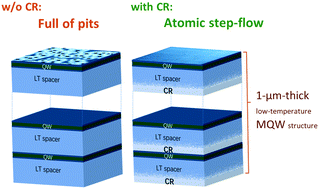High-temperature crystallinity restoring layers and their optimal positions for ultra-thick InGaN/GaN multiple-quantum-well structures
Abstract
Maintaining crystal quality during the growth of very thick multiple-quantum-wells is challenging due to the progressive deterioration in thick low-temperature barriers. The insertion of several high-temperature crystallinity restoring (CR) layers can significantly improve the surface morphology. Nevertheless, owing to their relatively high growth temperatures, their position still affects the luminescence of the nearby quantum well (QW). We observe that the photoluminescence (PL) intensity of the QW does not drop significantly when a high-temperature CR layer is grown directly on top of the QW; rather the intensity drops badly when an underlying CR layer is placed too close to the QW. Nitrogen vacancies (VN) generated in a CR layer can move upward into the QW and harm its optical properties. We believe a burying effect enables GaN spacers to block VN introduced by the CR layers, thus reduces the impact of CR layers on the QWs. We find the optimal position for the CR layers is right after each QW. 1 μm-thick MQWs with a smooth surface and good luminescence intensity are demonstrated with the implementation of CR layers.

- This article is part of the themed collection: Crystal Growth


 Please wait while we load your content...
Please wait while we load your content...